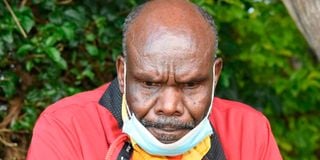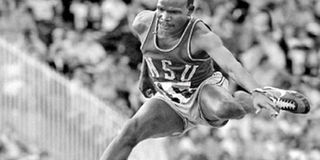Premium
Rono’s rise, success and fall came in quick succession

Legendary athlete Henry Rono, who broke four world records when he was an active athlete, during an interview with Nation Sport at his home in Kaptargon village, Nandi County on April 7, 2021.
What you need to know:
- Sundlun’s story is from the 1978 NCAA track championships in Eugene, Oregon in the United States of America
- A stranger at home, Rono, who died on Wednesday in Nairobi South Hospital at the age of 72, remains an athletics legend, the man who showed Kenyans how to break world records
- Off the track, Rono was a victim of the naivety of a village boy consumed by the woes of unfriendly western civilization
“Two people were put in this earth by God to run. One is (American middle distance runner) Mary Decker. The other is Henry Rono," Rono’s agent, American Tracy Sundlun, said in 1978.
“If you ever watched him, he was just on another planet", added Sundlun.
Sundlun’s story is from the 1978 NCAA track championships in Eugene, Oregon in the United States of America.
A stranger at home, Rono, who died on Wednesday in Nairobi South Hospital at the age of 72, remains an athletics legend, the man who showed Kenyans how to break world records.
The boycotts of 1976 (Montreal, Canada) and 1980 (Moscow) Olympic Games denied the world an opportunity to see Rono “the magical artist” running.
But his star has never faded. Many of those who chronicled his him say he was peerless. Rono once described himself in his own blog, [email protected], as “a man who stared into the abyss.”
“For those who live in a society that bared my soul and glorified me when I was on top of the world in the summer of 1978 and ridiculed me in the years when I was at the bottom of the world, I have succeeded - because I am a Nandi warrior," he wrote in the blog.

Kenyan distance running legend Henry Rono.
One man’s glorification stands out though in saluting the legend, runner George Malley, who set an American Record of eight minutes and 21.72 seconds in the steeplechase in the summer of 1978.
“Henry Rono’s 13:21.79 in the NCAA 5000m heats was aware some,” he wrote in the same blog.
“Those of us who saw it will always remember we were lucky; we saw running become art. Over the years we’ve all heard many athletes declare themselves to be ‘artists.’ Rono never claimed anything; he just ran.”
Malley said that Rono ran like a ‘performance artist’. His performances were ephemeral.” In an 81-day stretch in that same summer of 1978, Rono, a Washington State University sophomore, established world records in the 5,000m (13:08.4), 3,00m steeplechase (8:05.4), 10,000m (27:22.4) and 3,000m (7:32.1) - an achievement unparalleled in the history of distance running.
Mark Zeigler, a staff writer with San Diego Union Tribune wrote: “Everyone has his favourite story of Rono, who was honoured in 2008 by the IAAF Inspirational Award at the World Athletics Gala. He is also a recipient of the Running Legend Award at the annual Competitor Magazine banquet at SeaWorld in 2000.”
Sundlun was a coach at the University of Southern California and had a long jumper on the runway, defending NCAA champion Larry Doubley. Rono was on the track, running a preliminary heat of 5,000m.

Mike Boit (left) salutes fans accompanied by World 3,000 metres champion Henry Rono after finishing fourth in the 1,500 metres race during the Mike Boit Classic at Nyayo National Stadium in this photo taken in 1985.
Rono already had run the heats of the 3,000m steeplechase and set the NCAA meet record. He was comfortably ahead in 5,000m and essentially running it as a workout, jogging the curves, sprinting in the straights.
Rono rounded the turn at the same moment Doubley began charging down the long jump runway. Rono blew past him.
Sundlun swore: “It was like a Peugeot. All of a sudden his hips went back and his knees went up and vooooooom. He was just toying with everybody.”
That day, Rono set the NCAA meet record in 5,000m as well. Both records still stand. “I’ve always said that two people were put on this earth by God to run,” Sundlun, who later worked for Elite Racing in San Diego, said. “One is Mary Decker. The other is Henry Rono. If you ever watched him, he was just on another planet.”
Off the track, Rono was a victim of the naivety of a village boy consumed by the woes of unfriendly western civilization. And there was his own innocence. Rono had no financial manager, no investments, and no retirement portfolio.
“I took it personal, some of those things. I started drinking. I appreciate what I did in those years, what I did in running,” Rono wrote in his book “Henry Rono: Olympic Dream.”
“I did well. I just didn’t know how to manage it. Maybe it was an African guy coming to the Western world for the first time - it’s hard to handle that life. I’ve learned a lot. I’ve learned a lot about life, about reality.”
“By the early 1980s, he was drinking heavily and gaining weight. But even then, his legs did not betray him. In September 1981, he got drunk the night before a race in Oslo. He woke up the next morning and ran for an hour ‘to sweat out the alcohol.’ He went back to the hotel, took his lunch and took a nap,” said Zeigler.
That night, he ran the 5,000m and broke the world record. The rest is history. Rono beat the bottle many years later. He later trained with and coached Team Rono five days a week in Albuquerque, New Mexico.





